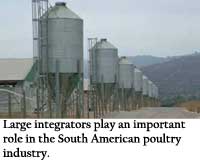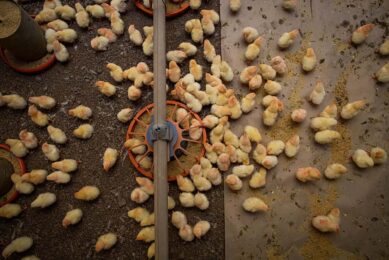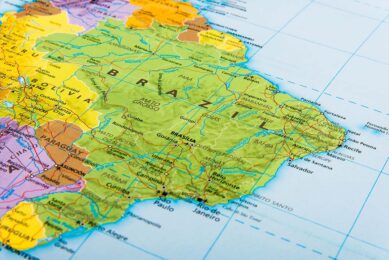South America eyes an optimistic future

The growth of the poultry industry in South America has been explosive in recent years. Due to the global financial downturn, however, expected growth was not achieved and margins decreased during the course of 2009. Despite this difficult situation, South American poultry producers are optimistic about the challenges and opportunities ahead. The big countries rule the roost.
By Carolina Rodríguez Gutiérrez , Chile
The economy is slowly recovering from the financial crisis that hit the world by the end of 2008. Despite this situation, most South American countries have pulled through tough times and are on track with rebuilding their economy. For 2010, growth prospects in the continent, based specifically on the Gross Domestic Product, will increase at a rate of 4%.
During 2009, the recession in the South American continent was short and fast. Now, Latin America is one of the few regions ahead in global recovery. Here, the economies are more diversified in terms of international trade, and have implemented more aggressive measures to give a boost to their markets.The resistance and recovery of the South American region is mainly due to macro-economic fundamentals in the region over the crisis of the past, redressing the major imbalances. Another decisive factor is the will exercised by governments in the region to implement counter-cyclical policies in order to strengthen their economies.Among South American countries that are predicted to lead growth in 2010 will be those that have the strongest domestic market, whose growth is less dependant on the external sector. These would be Brazil, Chile, Peru, Argentina, Colombia and Bolivia.
From domestic to export
During the recent decade, poultry farmers in the region have produced millions of tonnes of poultry, feeding the poultry sector with nutritious and inexpensive food. Meanwhile, these products have also satisfied much demand on the international market. The poultry sector in South American contributes approx. 20% of the production of poultry meat and eggs worldwide (Figure 1). This has been a direct result of investments made in technological innovation, and the production of competitively priced products of a high quality, while preserving the environment and paying attention to animal welfare. Future challenges that the sector will face include the higher costs of raw materials and fuels, new legislation and regulations, and the need to address the energy crisis.
During the recent decade, poultry farmers in the region have produced millions of tonnes of poultry, feeding the poultry sector with nutritious and inexpensive food. Meanwhile, these products have also satisfied much demand on the international market. The poultry sector in South American contributes approx. 20% of the production of poultry meat and eggs worldwide (Figure 1). This has been a direct result of investments made in technological innovation, and the production of competitively priced products of a high quality, while preserving the environment and paying attention to animal welfare. Future challenges that the sector will face include the higher costs of raw materials and fuels, new legislation and regulations, and the need to address the energy crisis.
Among the countries that have higher production volumes, in ascending order, are Brazil, Argentina, Colombia, Venezuela, Peru, Chile, Ecuador, Bolivia, Uruguay and Paraguay (Table 1, and Table 2).Exports are important in countries as Brazil, Chile and Argentina.
Brazil keeps growing
Despite the crisis, the Brazilian poultry industry maintained its growth rhythm. Production was 10.962 million tonnes of broiler meat, equivalent to the total volume of 2008, which it was a record for the sector (Figure 2). Brazilian consumption levels per capita have remained stable at approx. 39 kg of broiler meat per capita in 2009. In the analysis, the result was a victory for the sector, considering the problems encountered since the inception of the international crisis in the last quarter of 2008.It is likely that a significant amount of time will pass before the industry will feel the full effect of the merger of Perdigâo and Sadia (Brasil Foods), the growth of Tyson Brasil, and the incursion of Marfrig in the poultry industry, but the process has definitely begun.
Despite the crisis, the Brazilian poultry industry maintained its growth rhythm. Production was 10.962 million tonnes of broiler meat, equivalent to the total volume of 2008, which it was a record for the sector (Figure 2). Brazilian consumption levels per capita have remained stable at approx. 39 kg of broiler meat per capita in 2009. In the analysis, the result was a victory for the sector, considering the problems encountered since the inception of the international crisis in the last quarter of 2008.It is likely that a significant amount of time will pass before the industry will feel the full effect of the merger of Perdigâo and Sadia (Brasil Foods), the growth of Tyson Brasil, and the incursion of Marfrig in the poultry industry, but the process has definitely begun.
Although 2009 is probably not considered as one of the best years for the Brazilian poultry industry, it will be remembered as the year when the industry was significantly restructured. In general economic terms, a strong currency will benefit a country’s national economy, and will encourage investors. However, it must be noted that this is exactly the opposite with regard to exports.Brazil is the largest broiler exporter in the world. International sales of meat accounted for US$5.8 billion, which is 16.33% less than in 2008 in foreign exchange. The decrease in income is responsible for the price decrease, and the strength of the Real against the dollar, as export volumes remained relatively stable at 3.63 million tonnes of broiler meat, which is very similar to 2008 data.Due to the increase in price of Brazilian broilers as a result of the revaluation of Brazilian’s currency, major customers such as Russia, Japan and Venezuela declined their orders. In 2009, the Real rose 25.4% against the dollar, and became one of the currencies that strengthened in the year, which also contributed to Brazilian exports becoming more expensive. Therefore, the Brazilian Poultry Exporters Association (ABEF) aims to open new markets during 2010 to recover losses that occurred in 2009.
ABEF reports that this year it will approach markets such as the US, Mexico, Indonesia, Malaysia, Nigeria, Sudan and Senegal. In 2009, Brazil was the biggest poultry meat exporter for the 6th consecutive year. To maintain this leading position, Brazilian poultry farmers are facing the challenge of findingnew markets to expand during 2010.
Argentina on the rise
Producers in Argentina began 2009 with much uncertainty due to the economic crisis that began in October 2008, which caused exports to fall 30%. However, in 2009, Argentina exported 265,000 tonnes of poultry meat, achieving growth of 2% in volume over the previous year, although sales decreased 10%.
Producers in Argentina began 2009 with much uncertainty due to the economic crisis that began in October 2008, which caused exports to fall 30%. However, in 2009, Argentina exported 265,000 tonnes of poultry meat, achieving growth of 2% in volume over the previous year, although sales decreased 10%.
Production grew by 6.2% reaching 1.57 million tonnes of broiler meat by the end of 2009 (exceeded the aim that was set in 2002). Consumption of poultry meat increased to 34.3 kg per capita, which can be attributed to the low price of poultry meat compared to beef. Meanwhile, the poultry industry consumed 4.2 million tonnes of corn (3 million went to the broiler sector and 1.2 million to the egg industry) and 1.2 million tonnes of soybean pellets. The poultry sector in the region is a major grain processor. For 2010, the Centre of Poultry Processing Business Argentina (CEPA) expects 8-9% growth. The Centre has developed a plan for 2010-2017, firstly, to increase poultry meat consumption per capita per year 1-1.2 kg, reaching 39 kg in 2013 (the amount currently consumed in Brazil), and 44 kg in 2017 (current figure in the US). Secondly, the Centre aims to achieve 2.5 million tonnes of exports by 2017. However, investments are necessary to achieve this. CEPA therefore says the sector needs a credit of US$100 million annually. This will be used for building breeder houses, feed mills, hatcheries, broiler houses, slaughter plants, etc.
Large companies dominate in Peru
The Peruvian poultry industry grew by 7% during 2009. This development is supported by the strength of domestic demand despite economic slowdown. Sales in the poultry market, valued at farm prices, amounted to US$1.046 million annually, of which US$860 million for poultry meat and US$186 million for eggs. In 2008, 437 million chickens were lodged. Finally, the market traded 415 million broilers – a monthly average of 34.5 million. Of this amount, approx. 80% relates to the sale to the fresh market, and about 20% to further processed products (whole, packed, burgers, nuggets, etc).The poultry industry consists of about 30 large and medium-sized companies, which bring together 85% of Peruvian poultry production. The other 15% is from 200-300 small-scale producers, some of which are sub-contracted by leading companies. In the coastal region, 84% of national production is concentrated, and most of farms are professionally managed with intensive production systems. In the mountainous region and the jungles, family-owned farms dominate.
The Peruvian poultry industry grew by 7% during 2009. This development is supported by the strength of domestic demand despite economic slowdown. Sales in the poultry market, valued at farm prices, amounted to US$1.046 million annually, of which US$860 million for poultry meat and US$186 million for eggs. In 2008, 437 million chickens were lodged. Finally, the market traded 415 million broilers – a monthly average of 34.5 million. Of this amount, approx. 80% relates to the sale to the fresh market, and about 20% to further processed products (whole, packed, burgers, nuggets, etc).The poultry industry consists of about 30 large and medium-sized companies, which bring together 85% of Peruvian poultry production. The other 15% is from 200-300 small-scale producers, some of which are sub-contracted by leading companies. In the coastal region, 84% of national production is concentrated, and most of farms are professionally managed with intensive production systems. In the mountainous region and the jungles, family-owned farms dominate.
Per capita consumption of poultry in Peru is above average for Latin America – approx. 58 kg per year in Lima, and 28 kg at national level, according to Peruvian Poultry Association (APA).
Less than 1% of total production in Peru leaves the country, which primarily exports genetic products (hatching eggs, day-old chicks, and turkey chicks) to Colombia, Ecuador, Bolivia and Venezuela, and to a lesser extent, frozen poultry and turkeys. In 2008, Peruvian poultry exports reached US$12.3 million, 61% higher than the previous year.
The Peruvian poultry sector has also made many investments over the recent decade. Poultry production is the most valuable livestock sub-sector in Peru. From 2000-2008, poultry production increased 61.8%. During the first 10 months of 2009, despite the economic slowdown, production increased by 7.3% to 768,760 tonnes.
During the forecasted period, strong growth in production is expected and annual production is estimated to reach 1.22 million tonnes by 2014. Despite the generally optimistic view of Peru’s poultry sector, there are still problems, such as poor sanitation and lack of communication among producers, which makes disease control a problem.
Chile benefits from integration
Vertical integration is present in the Chilean poultry industry, ensuring the safety and quality of products from farm to table. Companies fully control the breeding of poultry, food production, slaughter, process, packaging, distribution and logistics, ensuring a high level of product traceability. Despite being a complex year, Chile managed to maintain their production level of 596,908 tonnes of broiler and turkey meat in 2009, being the sector least impacted in the Chilean meat industry, and increasing its exports over the previous year.Regarding domestic consumption, poultry remains the preferred meat, even though a slight decrease was seen in 2009 compared to 2008, amounting to 28 kg per capita. Total meat consumption, including other meat sources, reached 67 kg per capita.In 2009 there was a significant increase in imports of chicken (37.4%), mainly from Argentina. This was due to the fact that Argentina subsidises local poultry farmers, allowing them entry to Chile with subsidised products. Exports increased by 19.7% in volume reaching US$250 million. Also, new markets were found, including Malaysia, Guinea, Equatorial Guinea and Ecuador for broiler meat, and South Africa and French Territories in Africa for turkeys. The main destinations of poultry meat were the EU (39%), Mexico (31%) and China (11%). The US is also becoming more attractive.
Join 31,000+ subscribers
Subscribe to our newsletter to stay updated about all the need-to-know content in the poultry sector, three times a week. Beheer
Beheer








 WP Admin
WP Admin  Bewerk bericht
Bewerk bericht